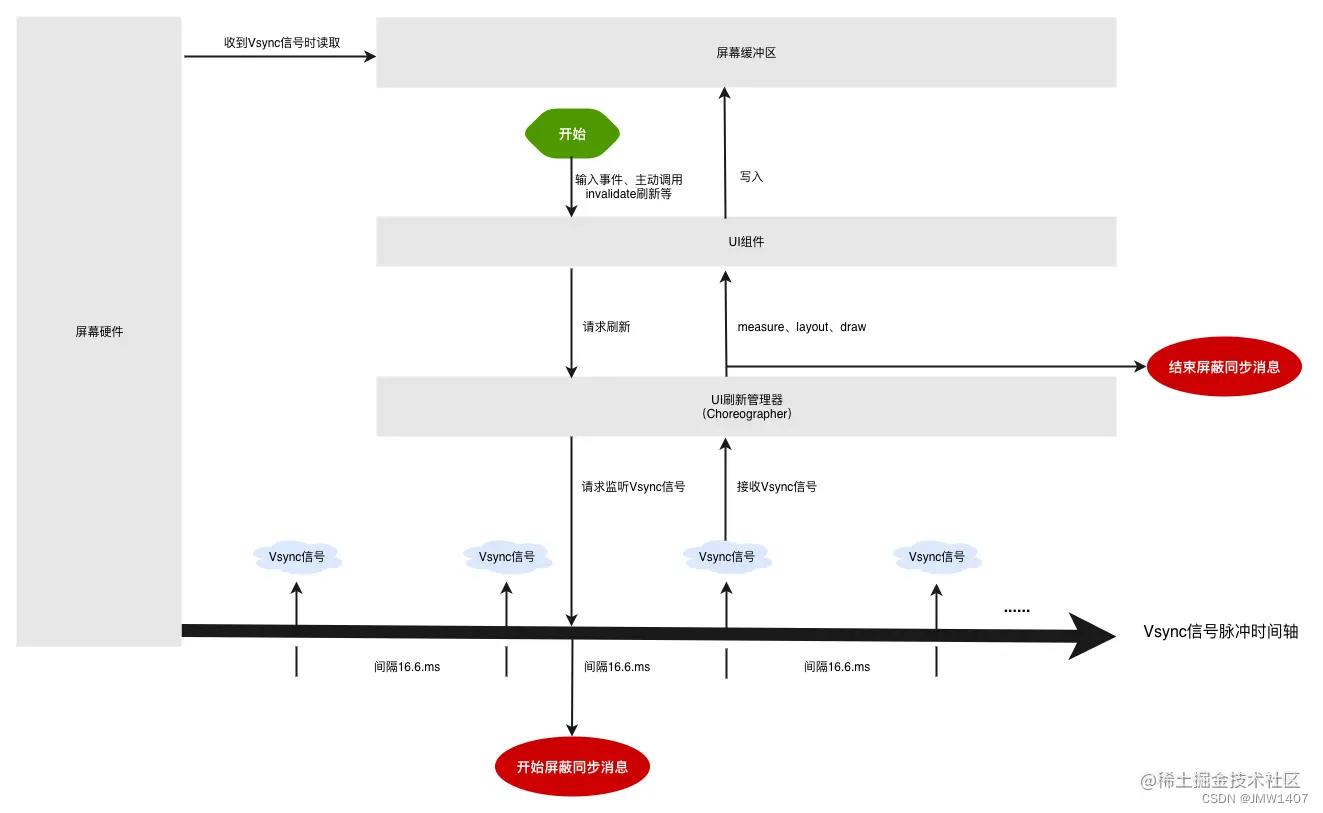Android:同步屏障的简单理解和使用
Posted JMW1407
tags:
篇首语:本文由小常识网(cha138.com)小编为大家整理,主要介绍了Android:同步屏障的简单理解和使用相关的知识,希望对你有一定的参考价值。
同步屏障的简单理解和使用
1、背景
这里我们假设一个场景:我们向主线程发送了一个UI绘制操作Message,而此时消息队列中的消息非常多,那么这个Message的处理可能会得到延迟,绘制不及时造成界面卡顿。同步屏障机制的作用,是让这个绘制消息得以越过其他的消息,优先被执行。
2、何为同步屏障?
Handler的message分为三种
- 同步消息
- 异步消息
- 屏障消息
通常我们使用handler发送消息,都是使用默认的构造函数构造handler,然后使用send方法发送。这样发送的消息都是普通消息也就是同步消息,发出去的消息就会在MessageQueue中排队。异步消息正常情况下跟同步消息没有区别,只有在设置了同步屏障之后,才会出现差异。
什么是同步屏障?
- 开启同步屏障的第一步需要发送一个特殊消息作为屏障消息,当消息队列检测到了这种消息后,就会从这个消息开始,遍历后续的消息,只处理其中被标记为“异步”的消息,忽略同步消息(所以叫“同步屏障”),相当于给一部分消息开设了“VIP”优先通道。当使用完同步屏障后我们还注意移除屏障。

那么同步屏障如何使用,如何运行的呢,主要分为以下四步:
- 发送屏障消息(Message中target为空,target的类型是Handler)
- 发送异步消息(发送被标记为asynchronous的消息)
- 处理消息
- 移除屏障消息(通过发送屏障消息时返回的token来删除消息)
2.1、 发送屏障消息——postSyncBarrier
MessageQueue中的postSyncBarrier方法:
public int postSyncBarrier()
// uptimeMillis会返回从系统启动开始到现在的时间(不包括深度睡眠的时间):milliseconds of non-sleep uptime since boot
return postSyncBarrier(SystemClock.uptimeMillis());
private int postSyncBarrier(long when)
// Enqueue a new sync barrier token.
// We dont need to wake the queue because the purpose of a barrier is to stall it.
// 上面的意思是放一个新的同步屏障消息到队列中,它就会一直在那挡着(直到你移除它)
synchronized (this)
// 屏障消息的token,作为唯一标识,用于移除屏障消息
final int token = mNextBarrierToken++;
// 循环利用Message对象
final Message msg = Message.obtain();
// 标记为正在使用,记录时间与token
msg.markInUse();
msg.when = when;
msg.arg1 = token;
// 下面代码的目的就是把屏障消息按时间排序插入到消息队列中,
// 前面的是早于自己的消息,后面的是晚于自己的消息
// 1、找到两个相邻的消息,使得 prev.when < msg.when < p.when
Message prev = null;
Message p = mMessages;
if (when != 0)
while (p != null && p.when <= when)
prev = p;
p = p.next;
// 2、插入屏障消息到prev与p之间
if (prev != null) // invariant: p == prev.next
msg.next = p;
prev.next = msg;
else
msg.next = p;
mMessages = msg;
return token;
该方法会返回一个token,在移除屏障消息的时候使用。
- 这里插一句,感觉很多人其实不理解token到底是什么意思,我们在用户登录的时候也会用到token,其实token的意义就是一个唯一标识,
token意思是“已经发生了”,就是给一个已发生的事物一个唯一标识。
postSyncBarrier的作用就是在消息队列中插入一个屏障消息,插入到什么位置呢,按消息的先来后到,排到对应的位置(消息都有记录when的,按when大小排队)。这里注意了,这个消息是没有给Message中的target赋值的,这个会作为后面判断是否开启同步屏障的依据。
2.2、发送异步消息
添加异步消息有两种办法:
- 使用异步类型的Handler发送的全部Message都是异步的
- 给Message标志异步
给Message标记异步是比较简单的,通过setAsynchronous方法即可。
Message msg = mHandler.obtainMessage(MSG_DO_FRAME);
msg.setAsynchronous(true);
mHandler.sendMessageAtTime(msg, nextFrameTime);
public void setAsynchronous(boolean async)
if (async)
flags |= FLAG_ASYNCHRONOUS;
else
flags &= ~FLAG_ASYNCHRONOUS;
Handler有一系列带Boolean类型的参数的构造器,这个参数就是决定是否是异步Handler:
public Handler(@NonNull Looper looper, @Nullable Callback callback, boolean async)
mLooper = looper;
mQueue = looper.mQueue;
mCallback = callback;
// 这里赋值
mAsynchronous = async;
在发送消息的时候就会给Message赋值:
private boolean enqueueMessage(@NonNull MessageQueue queue, @NonNull Message msg,
long uptimeMillis)
msg.target = this;
msg.workSourceUid = ThreadLocalWorkSource.getUid();
// 赋值
if (mAsynchronous)
msg.setAsynchronous(true);
return queue.enqueueMessage(msg, uptimeMillis);
2.3、处理消息
在MessageQueue的next方法中进行了消息读取,在这里做了同步屏障的相关判断:
......
int nextPollTimeoutMillis = 0;
for (;;)
......
// 阻塞,nextPollTimeoutMillis为等待时间,如果为-1则会一直阻塞
nativePollOnce(ptr, nextPollTimeoutMillis);
synchronized (this)
// Try to retrieve the next message. Return if found.
// 下面的代码目的是获取一个可用的消息,如果找到就return,
// 没找到就继续后面我省略的代码(省略了IdHandler的相关代码)
// 获取时间,还是通过uptimeMillis这个方法
final long now = SystemClock.uptimeMillis();
Message prevMsg = null;
Message msg = mMessages;
// 如果队列头部消息为屏障消息,即“target”为空的消息,则去寻找队列中的异步消息
if (msg != null && msg.target == null)
// Stalled by a barrier. Find the next asynchronous message in the queue.
do
prevMsg = msg;
msg = msg.next;
while (msg != null && !msg.isAsynchronous());
// 如果队列头部消息不是屏障消息,就会直接处理
// 如果是,就会获取异步消息,获取的到就处理,获取不到就去运行省略的代码
if (msg != null)
if (now < msg.when)
// 当前时间小于消息的时间,设置进入下次循环后的等待时间
// Next message is not ready. Set a timeout to wake up when it is ready.
nextPollTimeoutMillis = (int) Math.min(msg.when - now, Integer.MAX_VALUE);
else
// Got a message.
// 一个标记,表示next循环是不是还在被阻塞着
mBlocked = false;
// 移除消息
if (prevMsg != null)
// 移除异步消息
prevMsg.next = msg.next;
else
// 移除同步消息
mMessages = msg.next;
msg.next = null;
// 标记为正在使用
msg.markInUse();
return msg;
else
// No more messages.
// 没有获取到消息,接下来运行下面省略的代码,nextPollTimeoutMillis为“-1”,在循环开始的nativePollOnce方法将会一直阻塞。
nextPollTimeoutMillis = -1;
// Process the quit message now that all pending messages have been handled.
if (mQuitting)
dispose();
return null;
......// IdleHandler
// end of synchronized
......// IdleHandler
可以看到,在next方法的无限循环中,首先是nativePollOnce阻塞,然后是取消息的同步代码块(使用synchronized包裹),在这其中,首先取消息队列的头部消息(即mMessages),如果是屏障消息(消息的target为空),则寻找队列中的异步消息进行处理,否则直接处理这条头部消息。
在找到合适的消息后(if(msg != null)),会将即将处理的消息移除队列并返回;当然,如果没有找到就会将nextPollTimeoutMillis置为-1,让循环进入阻塞状态。
在next方法返回消息后,Looper会调用Handler的dispatchMessage回调到对应的方法中,我们来看看Looper.loop()方法:
public static void loop()
.....
for (;;)
// 无限取消息,“might block” 指的就是nativePollOnce的阻塞
Message msg = queue.next(); // might block
if (msg == null)
// No message indicates that the message queue is quitting.
// 如果返回的消息是空的,则会退出循环。如果循环没退出并且没有消息,则会被nativePollOnce阻塞着。
return;
......
// 分发消息,target即是发送消息的Handler
msg.target.dispatchMessage(msg);
......
// 回收消息
msg.recycleUnchecked();
最后Handler的dispatchMessage就会调用到handleMessage或者Message的callback(callback为Runnable对象),运行消息所指向的内容:
public void dispatchMessage(Message msg)
if (msg.callback != null)
handleCallback(msg);
else
if (mCallback != null)
if (mCallback.handleMessage(msg))
return;
handleMessage(msg);
2.4、移除屏障消息——removeSyncBarrier
使用同步屏障一定要记得移除消息,消息队列是不会自动移除的。我们通过MessageQueue的removeSyncBarrier方法移除屏障消息:
// Remove a sync barrier token from the queue.
// If the queue is no longer stalled by a barrier then wake it.
synchronized (this)
// 找出屏障消息
Message prev = null;
Message p = mMessages;
while (p != null && (p.target != null || p.arg1 != token))
prev = p;
p = p.next;
if (p == null)
throw new IllegalStateException("The specified message queue synchronization "
+ " barrier token has not been posted or has already been removed.");
// 移除屏障消息,并判断是否需要唤醒队列(nativePollOnce用于阻塞,nativeWake用于唤醒)
final boolean needWake;
if (prev != null)
prev.next = p.next;
needWake = false;
else
mMessages = p.next;
needWake = mMessages == null || mMessages.target != null;// 消息队列为空或者首个消息不为屏障消息
// 被移除的屏障消息需要回收
p.recycleUnchecked();
// If the loop is quitting then it is already awake.
// We can assume mPtr != 0 when mQuitting is false.
if (needWake && !mQuitting)
nativeWake(mPtr);
在removeSyncBarrier方法中,首先是去寻找屏障消息,找不到会抛出异常;
然后是移除屏障消息,并且判断是否需要唤醒消息队列继续取消息(唤醒next方法,这里的nativeWake用于唤醒,next方法中的nativePollOnce用于阻塞)。
2、系统什么时候添加同步屏障?
在请求监听Vsync信号时,阻塞Handler消息队列中的同步消息,优先保证接收Vsync信号的异步消息,及时生成新的屏幕数据,供屏幕显示。
 关于Handler同步屏障你可能不知道的问题
关于Handler同步屏障你可能不知道的问题
我们的手机屏幕刷新频率有不同的类型,60Hz、120Hz等。60Hz表示屏幕在一秒内刷新60次,也就是每隔16.6ms刷新一次。屏幕会在每次刷新的时候发出一个 VSYNC 信号,通知CPU进行绘制计算。具体到我们的代码中,可以认为就是执行onMesure()、onLayout()、onDraw()这些方法。
1、view绘制的起点是在 viewRootImpl.requestLayout() 方法开始,这个方法会去执行上面的三大绘制任务,就是测量布局绘制。但是,重点来了:
2、调用requestLayout()方法之后,并不会马上开始进行绘制任务,而是会给主线程设置一个同步屏障,并设置 VSYNC 信号监听。
3、当 VSYNC 信号的到来,会发送一个异步消息到主线程Handler,执行我们上一步设置的绘制监听任务,并移除同步屏障
- 这里我们只需要明确一个情况:调用
requestLayout()方法之后会设置一个同步屏障,直到VSYNC信号到来才会执行绘制任务并移除同步屏障。
@Override
public void requestLayout()
if (!mHandlingLayoutInLayoutRequest)
//校验主线程
checkThread();
mLayoutRequested = true;
//调用这个方法启动绘制流程
scheduleTraversals();
//在调用scheduleTraversals()的时候 postSyncBarrier添加同步消息屏障
@UnsupportedAppUsage
void scheduleTraversals()
if (!mTraversalScheduled)
mTraversalScheduled = true;
//1. 往主线程的Handler对应的MessageQueue发送一个同步屏障消息
mTraversalBarrier = mHandler.getLooper().getQueue().postSyncBarrier();
//2.将mTraversalRunnable保存到Choreographer中
mChoreographer.postCallback(
Choreographer.CALLBACK_TRAVERSAL, mTraversalRunnable, null);
if (!mUnbufferedInputDispatch)
scheduleConsumeBatchedInput();
notifyRendererOfFramePending();
pokeDrawLockIfNeeded();
...
//在doTraversal方法中移除同步消息屏障
void doTraversal()
if (mTraversalScheduled)
mTraversalScheduled = false;
//移除同步屏障
mHandler.getLooper().getQueue().removeSyncBarrier(mTraversalBarrier);
...
在这个方法中,涉及到三个比较重要的信息
- mTraversalRunnable
- 首先看
mTraversalRunnable,它的作用就是从ViewRootImpl从上往下执行performMeasure、performLayout、performDraw。
- 首先看
- Choreographer编舞者
- 同步屏障消息
Choreographer主要是为了配合Vsync信号,给上层app的渲染提供一个稳定的Message处理时机,也就是Vsync信号到来时,系统通过对Vsync信号的调整,来控制每一帧绘制操作的时机。当Vsync信号到来时,会往主线程的MessageQueue中插入一条异步消息,由于在scheduleTraversals中给MessageQueue中插入了同步屏障消息,那么当执行到同步屏障时,会取出异步消息执行。
看下Choreography中插入消息的方法是如何实现的:
private void postCallbackDelayedInternal(int callbackType,
Object action, Object token, long delayMillis)
synchronized (mLock)
...
if (dueTime <= now)
scheduleFrameLocked(now);
else
Message msg = mHandler.obtainMessage(MSG_DO_SCHEDULE_CALLBACK, action);
msg.arg1 = callbackType;
//设置为异步消息
msg.setAsynchronous(true);
mHandler.sendMessageAtTime(msg, dueTime);
参考
1 、什么是Handler的同步屏障机制?
2、关于Handler同步屏障你可能不知道的问题
3、图示Android系统原理之Handler同步屏障(三)
4、源码阅读#Handler(下)同步屏障与IdleHandler
以上是关于Android:同步屏障的简单理解和使用的主要内容,如果未能解决你的问题,请参考以下文章